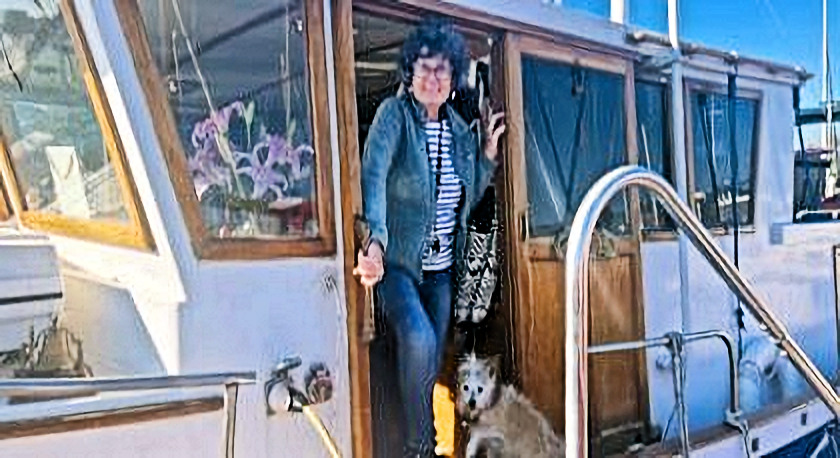
Stephenie Hollyman has been living aboard boats in various yacht harbors since 2013. In 2015 she bought a bought a36-foot tugboat and took up residence in the Berkeley Marina. Last January, she moved lock stock and binnacles to the Richardson’s Bay Marina, adjacent to the floating homes community.
She’s written an article about liveaboard life for the digital magazine Passagemaker which recounts the charms and challenges of living on the water within tight quarters. Here are some excerpts:
As a legal liveaboard in the San Francisco Bay area, I often feel like someone has handed me a rare gold coin. I wake up every morning to the gentle rocking of my boat with the salt air filling my lungs as I view the distant Golden Gate Bridge, often shrouded in fog. Living here is far cheaper than renting an apartment in the city, but what I really love are the sea and PoTolo, my 36-foot Sundowner tug.
San Francisco Bay is home to an unusual community of liveaboards. This lifestyle, while not for everyone, combines elements of minimalism, adventure and closeness to nature.
The Bay Area includes many boaters who would like to live on their vessels, but the criteria is selective. Regulations set up some 40 years ago prevent overpopulation and ensure a balanced use of resources. Only 10 percent of berths in most marinas can be populated by liveaboards in San Francisco Bay. Waiting lists are long to become one of the chosen few.
Mik Maguire, a broker with Richard Boland Yachts, suggests that aspirational liveaboards “meet personally with the harbormasters as you sign onto their waiting list. Sometimes you can jump the line if you fit the right criteria, if your boat is the right size and you seem responsible.” Maguire also suggests that boaters network at yacht clubs and go through a marina’s vetting process by renting a slip as a transient, which is allowed for three nights a week.
The demographics at Bay Area marinas cut a wide swath. Berkeley’s municipal marina has 100 slips available for liveaboards and is currently taking applications. In Sausalito, the eight independent marinas are mostly family-owned and include Clipper Yacht Harbor, where many slips are rented month to month. Oakland’s five marinas are run by Almar Marinas and leased from the Port of Oakland. And just a few miles from San Francisco International Airport, word has spread in aircraft cockpits that the Brisbane Marina in South San Francisco is a good place to “crash between flights,” as one berther told me.
Anyone thinking about living on a boat also has to embrace a minimalist lifestyle. Some say the forced simplicity of being in a smaller space can lead to a less-cluttered life.
I [recall returning] back to PoTolo in the early evening in time to catch the start of the Berkeley Yacht Club beer can races. I climb up to the pilothouse roof, plop into a beanbag and gaze at the billowing, multicolored spinnakers as crews douse them after racing. Heading back to the galley, I coat some halibut fillets that a neighboring fisherman gave me, and I reflect on a visit I made earlier to Boland, the yacht broker.
His first experience living on the water was in the roaring 1960s. “You live on a boat, right?” he asks me with classic salesman intensity. “You wake up in the morning and you hear the wildlife, the clattering of lines on sailboats and all the sounds that go with boating, right? You have a sense of excitement every day you wake up. It’s different. There’s an energy to living on a boat, living on the water, that you cannot find living in an apartment or house on land.”
And, unlike floating homeowners, Stephenie can take her home out for a spin whenever she wants. Brunch at the Corinthian Yacht Club, anyone?